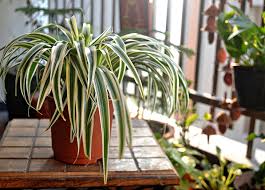In today’s fast-paced and stressful work environment, creating a healthy and vibrant office space is paramount. Incorporating indoor plants into the workplace not only enhances the aesthetic appeal but also improves air quality, reduces stress levels, and boosts productivity. These living wonders are nature’s remedy for the confines of the corporate world. In this article, we will explore the top indoor plants that thrive in office environments, bringing a breath of fresh air and a touch of tranquility to your workspace.
The Spider Plant (Chlorophytum comosum)
The Spider Plant is a wonderful choice for a flexible and visually appealing addition to your workspace. Its arching foliage, covered with tiny spiderettes, gives a touch of sophistication to any situation. Spider plants are well-known for their air-purifying properties, which efficiently counteract typical indoor contaminants such as carbon monoxide and formaldehyde. Furthermore, they release oxygen and boost humidity levels, generating a more pleasant and refreshing atmosphere for employees.

Watering
Spider Plants prefer moderately moist soil, but they are also tolerant of occasional underwatering. It’s important to maintain a balance and avoid overwatering, as excessive moisture can lead to root rot. Here are some watering tips for your Spider Plant. Frequency: Water your Spider Plant thoroughly when the top inch of soil feels dry to the touch. This usually translates to watering once every 1-2 weeks. However, adjust the frequency based on the temperature, humidity, and light conditions in your office.
Fertilization:
During the spring and summer seasons, feed your Spider Plant with a balanced, water-soluble houseplant fertilizer once a month. Fertilize every 2-3 months during the months of autumn and winter, when the plant’s growth slows.For dilution ratios, follow the fertilizer instructions on the package. To avoid overfertilization, it is generally advised to use a half-strength solution.Apply the diluted fertilizer to the soil around the plant’s base. Avoid getting into close touch with the leaves, because this might result in fertilizer burn.
Peace Lily (Spathiphyllum)
Look no further than the Peace Lily for an office indoor plant that symbolizes both beauty and elegance. This plant evokes calm and tranquillity with its glossy rich green leaves and amazing white blossoms. The Peace Lily flourishes in low-light conditions, making it an ideal choice for office environments with minimal natural light. It not only improves the appearance of the space, but it also removes the air by eliminating risky substances like ammonia, benzene, and formaldehyde.

Watering
Peace Lilies love to be evenly wet but not soggy. Before watering again, allow the top inch of soil to dry somewhat. Check the moisture level of the soil with your finger. Watering is usually done once every 1-2 weeks. The frequency should be adjusted according on the humidity and temperature in your office.
Method of Watering: Water the plant when the bottom of the pot is entirely dry. Underwatering and overwatering indications include: If the leaves begin to droop or turn pale, this indicates that the plant requires water. Overwatering can cause yellowing foliage or root rot, so alter your watering schedule accordingly.
Fertilization:
Fertilize your Peace, Lily, every 2-3 months during the growing season, which lasts from spring till early autumn. Avoid fertilizing during the winter months, when the plant’s growth slows. Use a balanced, water-soluble fertilizer made solely for indoor plants. Look for a fertilizer with an N-P-K ratio of 10-10-10 or 20-20-20. Rinse the soil with plain water on a regular basis in order to remove any fertilizer buildup. It also helps prevent salt buildup and maintains the plant’s roots healthy.Temperature, light levels, and pot size could all have an effect on the plant’s requirements. To provide the best care, check the soil moisture and determine the plant’s overall well-being on a regular basis.
Pothos (Epipremnum aureum)
Pothos is an increasingly common choice among office workers because to its versatility and resilience. Its heart-shaped leaves in different hues of green make it a striking complement to any office. Pothos is an ideal plant for newbies since it takes little care and can perform well in a wide range of light situations. This tough plant also excels in air purification, effectively eliminating chemicals like formaldehyde and xylene, promoting a healthier and more productive workplace.

Watering
Pothos plants are generally water-tolerant, and they cherish a somewhat drying cycle between waterings. Here’s an overall watering strategy for your Pothos. Water the plant until the bottom of the pot is entirely dry. To prevent moist roots, make sure the bowl is entirely clear. Overwatering pothos plants may result in root rot. It is better to slightly underwater than to overwater. Keep an eye on the plant’s leaves and alter your watering plan accordingly.
Fertilization
During the growing season, which lasts from spring to early fall, feed your Pothos with a balanced, water-soluble fertilizer every 2-4 weeks. During the winter, when the growth of the plant slows, reduce fertilization to once every 1-2 months. During regular irrigation, apply the diluted fertilizer to the soil surrounding the plant’s base. To prevent fertilizer burn, avoid contact with the leaves. Clean the soil with plain water on a regular basis in order to remove any fertilizer buildup. This helps prevent salt buildup and keeps the plant’s roots healthy.
Rubber Plant (Ficus elastica)
The Rubber Plant is a great stunner for anyone looking for an eye catching plant that grabs attention. Its huge, glossy leaves in rich green offer a striking and appealing presence in any workplace setting. Aside from its visual appeal, the Rubber Plant is excellent in air purification, particularly the removal of formaldehyde. This plant requires little care.
Watering
Rubber plants require careful watering since they are sensitive to both overwatering and underwatering. To effectively water your Rubber Plant, follow the suggestions below. Before watering, allow the top inch of soil to dry off. Check the moisture level of the soil using your finger. It’s time to water your Rubber Plant if it seems somewhat dry. When the soil becomes somewhat dry, properly water your Rubber Plant. This typically involves watering every 7-10 days. The frequency, however, may vary based on aspects such as temperature, humidity, and light levels in your office. Overwatering produces root rot in rubber plants. It is preferable to slightly underwater than to overwater. Keep an eye on the plant’s leaves and alter your watering plan accordingly.
Fertilization:
During the growth season, which lasts from spring to early fall, fertilize your Rubber Plant every 2-4 weeks. During the winter, when the plant’s development declines, reduce fertilization to once every 1-2 months. Use a water-soluble, balanced houseplant fertilizer with an equal N-P-K ratio, such as 10-10-10 or 20-20-20. You may also use a fertilizer designed exclusively for leafy plants. In general, half the recommended strength is advised. During regular watering, apply the diluted fertilizer to the soil around the plant’s base. To avoid fertilizer burn, avoid direct touch with the leaves.To eliminate any fertilizer buildup, just remove the soil with simple water. This helps prevent salt buildup and keeps the plant’s roots healthy.

